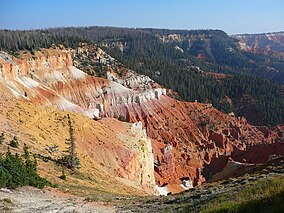Cedar Breaks National Monument
| Cedar Breaks National Monument | |
|---|---|
|
IUCN category V (protected landscape/seascape)
|
|

Cedar Breaks amphitheater
|
|
| Location | Iron County, Utah, U.S. |
| Coordinates | 37°38′33″N 112°50′56″W / 37.6424776°N 112.8488318°WCoordinates: 37°38′33″N 112°50′56″W / 37.6424776°N 112.8488318°W |
| Area | 6,155 acres (24.91 km2) |
| Created | August 22, 1933 |
| Visitors | 493,147 (in 2011) |
| Governing body | National Park Service |
| Website | Cedar Breaks National Monument |
Cedar Breaks National Monument is a U.S. National Monument located in the U.S. state of Utah near Cedar City. Cedar Breaks is a natural amphitheater, stretching across 3 miles (4.8 km), with a depth of over 2,000 feet (610 m). The elevation of the rim of the amphitheater is over 10,000 feet (3,000 m) above sea level.
The eroded rock of the amphitheater is more eroded than, but otherwise similar to formations at nearby Bryce Canyon National Park, Red Canyon in Dixie National Forest and select areas of Cedar Mountain (SR-14). Because of its elevation, snow often makes parts of the park inaccessible to vehicles from October through May. Its rim visitor center is open from June through October. Several hundred thousand people visit the monument annually. The monument area is the headwaters of Mammoth Creek, a tributary of the Sevier River.
Wildlife can often be seen in this high altitude setting. Mule deer and porcupines are common, as are rodents and similar animals such as marmots, golden-mantled ground squirrels, pocket gophers, and chipmunks. Mountain lions and other larger animals live in the area but are seldom seen. Common birds include the Clark's nutcracker, violet-green swallows, and the common raven.
The bristlecone pine, a species of tree that is known as the longest living single organism, can also be found in the high country, with some local specimens known to be more than 1600 years old. Sub-alpine meadows dot the canyon rim in such areas as Alpine Pond, which is an easy hike from the road along a clear trail. Aspen, Engelmann spruce, subalpine fir trees, and limber pine also grow here.
...
Wikipedia

